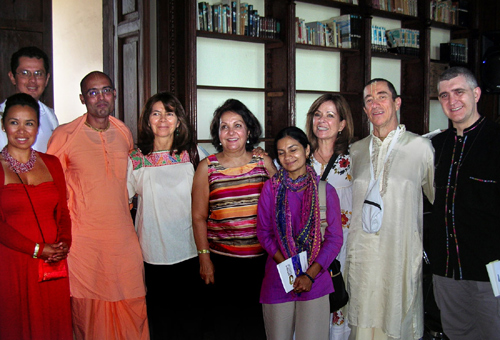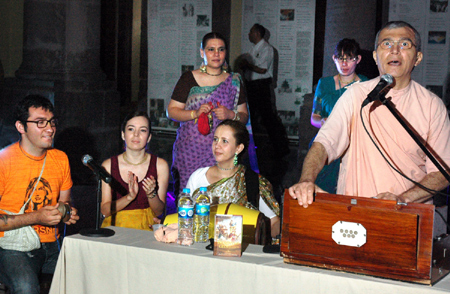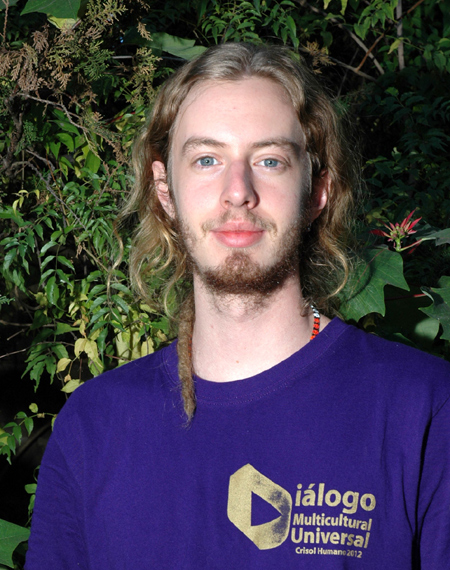|
By John Pint
 A
Universal Multicultural Dialogue took place in Guadalajara, Mexico
between August 29 and September 2, 2012. Hundreds people from a dozen
countries participated in the five-day event which included workshops,
rituals of many religions, panel discussions and conferences by
representatives of numerous religions and spiritual movements. A
Universal Multicultural Dialogue took place in Guadalajara, Mexico
between August 29 and September 2, 2012. Hundreds people from a dozen
countries participated in the five-day event which included workshops,
rituals of many religions, panel discussions and conferences by
representatives of numerous religions and spiritual movements. The
venue of the Dialogue was the Museum of Western Archaeology, housed in
a venerable 18th century building which once served as a convent for
Augustinian Nuns.
The objective of the event was to convene an
international forum of people of diverse ways of thinking and belief,
regardless of race, creed or social status, who are dedicated to a
better world. Here they discussed topics such as: Faith and
Globalization; Cultural Identity and Migration; Exploring Respect for
Life in terms of Ecology, Human Rights, Childhood and the Wisdom of
Elders; the Role of Women; Indigenous Voices; Spirituality Without
Religion and other subjects.
The Dialogue was organized by Carpe
Diem, an association founded in Guadalajara by a mixed group of
humanists including an architect, a psychologist, a businessman, a
linguist, an Anglican Priest and Jorge Manzano Vargas of ITESO, a Jesuit university in Guadalajara.
The
event brought together representatives of many major religions,
allowing them to learn about one another and even participate in the
rites and rituals of different Faiths. Buddhist participation in the
event was thanks to Dr. Mario Domínguez Cross, who directs the Mexican
branch of Khamlungpa, a world-wide organization under the Dalai Lama.
Dr. Domínguez Cross brought Lama Zoparimpoche and Lama Gueshe Lobsang
Khedup to the conference, where they spoke on Mahayana Buddhism, as
practiced in Tibet. Lama Khedup also led a meditation session, one of
many religious rituals which anyone could attend.
An open-minded
Catholic view on Buddhism was presented by Guadalupe missionary José
Sandoval Ińiguez. He stated that “Buddha was one of the precursors of
Jesus Christ, along with Socrates and John the Baptist. Another thing
they had in common was that none of them ever wrote anything down, but
left this to their disciples, after their deaths.”
Well-known and
controversial Catholic theologian Hans Küng joined the gathering from
Switzerland via videoconference and spoke on the Future of
Spirituality. After years of insisting on reform in the Church, Küng
was named a theological consultant for the second Vatican Council by
Pope John XXIII. The now 84-year-old Küng said, “There will be no peace
among the nations without peace among the religions.”

Other popular
speakers were Alberto Ruz buenfil Coyote, leader of the 13-year Rainbow
Caravan for Peace, whose subject was “From Utopia to Ecotopia, One
Nation without Borders,” and James Doty, who spoke on Science and
Spirituality. He is a Professor of Neurosurgery at the Center for
Compassion and Altruism Research and Education (CCARE) supported by the
Dalai Lama.
Particularly popular was a workshop on Pneuma Breathwork
conducted by Juan Ruiz Naupari, founder of the Pneuma System, a kind of
Yoga which “integrates psycho-spiritual teachings and practices that
are both modern and ancient from the esoteric traditions of the East
and West into a comprehensive whole. It is a path of synthesis, which
brings together the inner wisdom of the major traditions of the world,
and thus offers a new vision of spirituality for the new era.”
Extraordinary
in this get-together was the active participation of numerous
indigenous groups of Mexico, such as the Mayas, Huicholes, Rarámuri,
Mexicas and others. They took advantage of this occasion to remind
Mexico and the world that they exist and deserve as much support as any
of the other groups present. They also conducted a great many of the
rites and dances which took place between conference sessions.
The
Universal Multicultural Dialogue drew people from numerous overseas
organizations, such as the One Global Family Foundation, the Vedanta
Societies, the Spiritual And Religious Alliance for Hope (S.A.R.A.H.),
the Bahá'í International Community, and the Chicago-based Council for a
Parliament of the World’s Religions. “Carpe Diem did a phenomenal job,”
commented Parliament member Laura Ava-Tesimale of American Samoa. “This
conference is a stepping stone for what is to come and it’s exciting to
be a part of it.”
Buddhist representative Dr. Domínguez Cross
commented that “The organizers carried out this event with
extraordinary dedication and compassion, with simplicity and humility.
I saw that the philosophies and rituals of the groups represented here
are enormously different, but all of them showed great respect toward
the others. We could see that deep underneath, each of them is trying
to say the same thing, although they speak in different manners.”
Krishna
Balaram Das, from India, who gave a presentation on Yoga for the Modern
Age and Mantra Mediation, said that this event was “a quantum leap
toward spiritual understanding and unity among all religions and human
beings. It’s a wonderful initiative to develop harmony, peace and
brotherhood globally.”
Iranian Vida Sapir of the Bahá'í Community in Mexico, said, “It was
wonderful. It was a real example of unity in diversity.”
Another
presenter at the multicultural Dialogue was Sande Hart of the women’s
interfaith organization S.A.R.A.H and co-founder of “I am Jerusalem,”
an organization which emphasizes the common roots of Judaism,
Christianity and Islam. Ms. Hart noted that there were four important
threads at the conference: the necessity for the rise of the feminine
spirit, the fall of ultra-machoism and, number three, “the idea that
human society has reached a critical point in its evolution where we
either change or die.” The fourth thread surprised her most of all:
“Many speakers, including men of the cloth, are discovering that
religion gets in the way of growth, of progress.”
When asked to
comment on the organization of the event, Ms. Hart said, “I try to go
to all interfaith events. I feel the need to put my efforts into ending
religiously motivated violence. I came here not only to share our
successes, but to learn from others so I can bring it back and better
our work. This particular conference I feel was very special and
groundbreaking. I felt elevated at this event, something I didn’t
expect. Most interfaith events are pretty much ‘preaching to the
choir.’ We listen to poetic ways to express the need to get out there
and do something, but we rarely hear how to do it, about the tools for
doing it. But never in my life have I witnessed such a beautiful spirit
of volunteerism as I have seen here, inside this cultural center, so
pure and so consistent, so welcoming and warm and comforting. Seeing
these young people gave me regained hope in humanity. I didn’t get this
from the speakers, because I have heard it all before, year after year,
but I got it from the actions of the volunteers. To me, that was
glaring: it’s not our words; it’s our actions. This is something I hope
to take back with me over the border.”
Carpe Diem hopes to hold a second Universal Multicultural Dialogue in
2014.
Below: Read the moving
reflections of a volunteer at the Dialogue.
A
VOLUNTEER REFLECTS ON THE MULTICULTURAL DIALOGUE
By Elias González
My
guest writer here is Elias González, a student of philosophy at ITESO
(Guadalajara’s Jesuit University) and a volunteer at the Dialogue. His
moving reflections (beautifully translated by Bill Quinn) on this
extraordinary inter-faith gathering offer us a chance to witness the
impact of the event on an individual and raise hope for that Better
World so many humanitarians have dreamed of. These are excerpts from
Elias González’ article “A Volunteer’s Experience – This is What I
Experienced at the Multicultural Dialogue,” which appeared in the
magazine Xipe Totek, XXI-4, No. 84. 2012. You can also find the full
text here. John Pint
………….
 Ever since I was little I’ve
loved reading about religions, cultures, history; how I see myself as
syncretic: sometimes I feel I’m too Catholic to be Buddhist, too new
age to be Catholic, and too Buddhist to be new age. But I can’t help
but wonder, are these three positions really so separate that they
can’t co-exist? Ever since I was little I’ve
loved reading about religions, cultures, history; how I see myself as
syncretic: sometimes I feel I’m too Catholic to be Buddhist, too new
age to be Catholic, and too Buddhist to be new age. But I can’t help
but wonder, are these three positions really so separate that they
can’t co-exist?
Day One. The Museum of
Archeology of Western
Mexico needed cleansing. It seemed like an old tree that had witnessed
much, far too much hatred and violence; there was a heaviness, an
overwhelming gray atmosphere. When I arrived, I ran into Manuel, my
pragmatic meditation teacher, together with a marakame (Huichol shaman)
and other people in a line, carrying out a cleansing ritual in the
dark, old building. I joined them. If the energy I had felt was dark
and old, when I opened channels to carry out the cleansing, a surge of
feelings rose up in me: the place had been a seminary, and then a
military headquarters. Lord knows what went on in that space, but the
energy was clear enough. It was Mexico in miniature: its wounds and
sufferings were concentrated there. The atmosphere was
suffocating, I couldn’t breathe, and only the strength of all of us
together could cleanse and heal something like that. We finished the
cleansing ritual and the Multicultural Dialogue began just a few
minutes behind schedule.
Dancers from the ancient past, purified
the
stage with divine, ancestral movements, their meaning lost and
recovered generations before. Their feathers fluttered through space;
hundreds of people had gathered in response to the call to a change of
consciousness –fewer than hoped but more than I expected. It was the
right number. The sound of the drum ushered in the guests of
honor—government officials, representatives of the Parliament of
Religions with its headquarters in Chicago, and members of Carpe Diem
(a Guadalajara-based, humanistic association) walked up onto the stage
one by one to take their places. One of our indigenous sisters, of the
Purepecha people, of universal blood and voice, spoke first. She gave
permission, expressed her emotion and gratitude, on her own behalf and
on behalf of the indigenous of this earth… she gave permission, and
then the deluge was on us. The tent was of no use: enormous hailstones
tore through the plastic and water flowed freely everywhere. People ran
and shouted, and the volunteers jumped into action with a mix of
frustration and rapid response as we set about controlling the people
and saving the electronic equipment. I spontaneously hugged a friend of
mine and laughed, laughed for joy: this wasn’t “bad luck” or cause for
frustration. It was the necessary purification. Our cleansing ritual
had not been enough: Tláloc himself had intervened to finish the
purging of the premises. It was a beautiful spectacle, a display of
humility in the midst of so much paraphernalia and superficiality with
which we had surrounded ourselves. The message was that this event was
to be simple, without so many flashing lights, without so many exterior
things.
The inauguration took place in an
adjacent hall while a chorus
of angel-like voices sang “En son de paz” (“In peace”) with all their
strength, without microphones and without background music, with just a
natural amplifier and an unmatched symphony of rain and hail. And then
the rain stopped. And then, the Xipe Totec dancers, with whom I have
had the privilege to dance, did the most beautiful prayer: the dance of
Quetzalcóatl. Many people had run from the museum when the rain came;
nevertheless, the dance drew a crowd. We all took hands and shouted,
“Eiaeiaaaa! Eiaeiaaaa!” Energy and ecstasy flowed through each one of
the participants. We became a single feathered serpent dancing and
flying over the Earth, purifying the building and the place where the
event would truly take place, transforming the hearts of one and all.
Day one came to an end…
Friday. I listened for a moment to a
panel
with Jorge Manzano, co-founder of Carpe Diem, Rabbi Joshua, a minister
from the Anglican Church, a priest from the Catholic diocese and
Ernesto, an expert in music. Jorge surprised everyone with his soccer
metaphor, in which every player on the team represents a different
tradition: the Catholic is the goalkeeper, the Buddhist plays midfield,
the striker is from the Bahá’í faith, and so on. Jorge posed the
following question: “If the Jew makes a bad pass to the Bahá’í, who
then misses the shot, who loses the game?” The answer made a deep
impression on all of us: “The whole team,” said a member of the
audience. Correct answer. In the final analysis it doesn’t matter what
our tradition is. The fact is we all play on the same team, competing
in this world to make it a kinder, more compassionate place where love
and peace reign. That’s the common goal, the goal that we all want to
score. But we have to do it as a team knowing that it’s the only way.
If one misses, we all miss; if one scores, we all score…
Saturday
night. The whole museum came to a halt and the attention of
all
the participants, speakers and volunteers was concentrated on the
central courtyard. It was the blessing ceremony. José Antonio, a great
teacher whom I had just met at the event, and I, were in charge of
backstage operations. The speakers and representatives of the cultures
and traditions took their place on the stage: Sebastián, Ana Tere,
Mario, Guadalupe, Susana, Evelia, Jorge, representatives of the
Ecumenical Church, the Anglican Church, Pedro Pablo, Andras, Lauro
(Peruvian shaman), Muslims, Jews and representatives of the Parliament
of the World’s Religions, one by one, in their own spiritual language,
gave us their blessing. Drums sounded, holy water was poured on us, the
wind and the Peruvians’ bells moved us, the chants of the shamans and
the Celts surrounded us, and the wise, poetic words enlightened us. It
was at that moment that Jorge told us, “And may your faces always be
beautiful and happy.” That’s the way it was and that’s the way it will
be, because the energy that came to us in each of the blessings will
urge us on for the rest of our lives. Every time I feel I can’t go on;
that the struggle for justice, faith, peace and love is blocked and
sabotaged by the corruption and suffering of this world; every time my
strength flags or quits me entirely, the memory of that night will be
with me, when a few gathered in representation of many. We gave
everything we had for a common aspiration, the desire to live together,
the desire of love. When the time came, Carlos spoke. I can’t remember
his exact words, because I was holding a sign with the Golden Rule:
“Treat others as you would treat yourself.” I held it high and with
pride so that everyone could see it as we listened to Carlos, the
director of Carpe Diem and father to us all. The applause was long, the
longest I’ve ever heard in my life; people’s hands and arms did not
tire; we took our energy from the atmosphere, and everyone standing,
with our feelings stuck in our throats ready to make us burst into
tears, we applauded without knowing when it would stop. I can still
hear the clapping of all those people, dreamers but realists, mystics
but activists, peaceful but committed… We were one sound, one song, a
mythical melody, a story, a legend. We lived a legend, a legend whose
wind will continue to blow and motivate each and every one of us
individually in our particular struggles for peace, and it will
motivate us as a community to celebrate once again in two years’ time.

|

